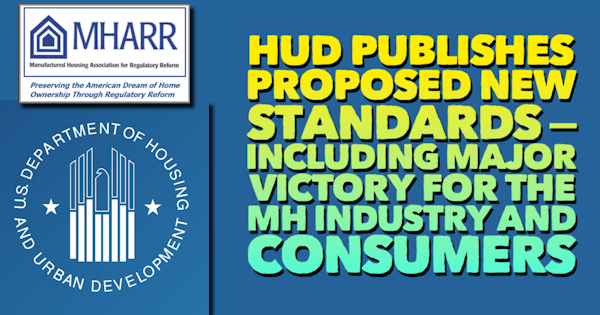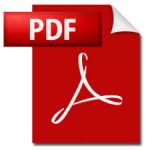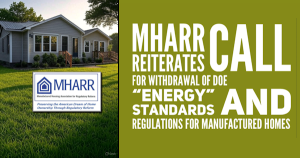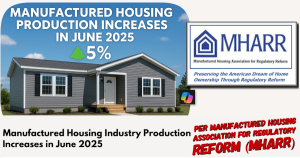HUD Publishes Proposed New Standards – Including Major Victory for the MH Industry and Consumers

HUD PUBLISHES PROPOSED NEW STANDARDS – INCLUDING MAJOR VICTORY FOR THE MH INDUSTRY AND CONSUMERS
The HUD Office of Manufactured Housing Programs (OMHP) has published an extensive set of proposed new construction and safety standards and regulations for federally-regulated manufactured housing. The HUD Notice of Proposed Rulemaking (NPR), published in the July 19, 2022 edition of the Federal Register (see, copy attached) addresses – and would adopt (with certain adjustments) – the so-called fourth and fifth group of standards recommendations submitted to HUD by the statutory Manufactured Housing Consensus Committee (MHCC).
Among the multiple standards changes and additions set forth in the NPR, are three that are of particular significance to the HUD Code industry, American consumers of affordable housing and the HUD Code manufactured housing market more broadly. Comments in response to the NPR are due by September 19, 2022. Given the importance of these issues – and particularly the supposedly “voluntary” sprinkler criteria contained in the NPR – MHARR will consult with members and submit relevant comments to HUD.
The three particularly significant standards-modifications and additions contained in the NPR are addressed in further detail below —
Multi-Dwelling Manufactured Homes: The first of the three major HUD actions is the promulgation of new standards that would permit the construction and sale of multi-dwelling unit manufactured homes with up to three dwelling units contained in a single structure. MHARR is – and has been – a strong proponent of these changes. The changes are an outgrowth of an October 3, 2014 warning issued to manufactured housing producers by former HUD manufactured housing program administrator, Pamela Danner, to avoid the production and/or marketing of anything other than “single-family” manufactured homes, based on alleged regulatory restrictions barring multi-family or multi-unit HUD Code homes. MHARR immediately objected to this alleged “guidance” on the ground that the “single-family” limitation contained in the HUD regulations was not based on any supporting language in the National Manufactured Housing Construction and Safety Standards Act of 1974 (as amended by the Manufactured Housing Improvement Act of 2000) and, in fact, was inconsistent with the definition of “manufactured home” contained in the statute. This activity was described in a January 2015 MHARR memorandum regarding the Association’s efforts to advance this crucial aspect of parity between manufactured housing and other types of housing as follows:
This MHCC activity relates back to an October 3, 2014 guidance memorandum issued by the HUD program administrator, warning of enforcement action against any HUD-labeled home designed and built for “multi-family or non-single-family residential use” based on the definition of “dwelling unit” contained in section 3280.2 of the HUD standards — which provides that a manufactured home, as a “dwelling unit,” must be “designed to be occupied by one family.”
In a November 12, 2014 communication to the program administrator – and again at the December 2014 MHCC meeting – MHARR stressed that the “single-family” restriction contained in 3280.2 exceeds relevant statutory authority in that the statutory definition of “manufactured home” states that a manufactured home is a “dwelling,” but does not otherwise define or limit a “dwelling” – expressly or implicitly — to being a “single-family” home. Thus, there is no statutory support for the 3280.2 restriction of a “dwelling unit” to occupancy “by one family.”
This aggressive MHARR objection forced the Administrator to back down, ultimately leading to MHCC consideration of additions and modifications to the standards to support multi-dwelling unit manufactured homes. Now, after seven years, HUD is finally promulgating those standards to permit and authorize the utilization of HUD Code homes for multi-family situations with up to three units.
This step represents a significant victory for the manufactured housing industry, that will open new markets for HUD Code homes in full competition with other types of housing.
Wind Resistance Criteria: The second major update contained in the July 19, 2022 proposed rule, would update the reference standard for the HUD Code’s wind resistance criteria from the 1988 version of the American Society of Civil Engineers (ASCE) reference code to the 2005 version of that code. Consistent with this update, the “three second gust” (as opposed to the current “fastest mile”) wind resistance criteria would be 140 MPH in Wind Zone II and 150 MPH in Wind Zone III. Again, this change is consistent with the consensus recommendation of the MHCC. Notwithstanding that point, however, MHARR will seek further input on whether the change/update is warranted and cost-effective, and whether it is consistent with the express terms and purposes of applicable law, and will submit appropriate comments to HUD.
“Voluntary” Sprinkler Standard: The third significant modification contained in the July 19, 2022 NPR is a proposal that would establish “voluntary” standards “for the design and installation of fire sprinkler systems when a manufacturer chooses to install such a system….” Such standards, sought by the Manufactured Housing Institute (MHI) and recommended by the MHCC after years of contentious debate, have been consistently opposed by MHARR (dating back to 1987) for multiple reasons, including but not limited to the following:
- The insertion of fire sprinkler standards into the HUD Code, even if “voluntary,” could – and likely would – ultimately lead to mandatory sprinkler standards as a result of regulatory “mission creep;”
- There is no provision – and no valid basis – for the establishment of “voluntary” standards under the 1974 manufactured housing Act as amended;
- A voluntary fire sprinkler standard is not needed to federally-preempt state and/or local fire sprinkler mandates, as a valid basis for such preemption can be inferred from the language of both the Act and already-existing “fire safety” standards; and
- Fire sprinklers are substantively unnecessary, as is demonstrated by Foremost Insurance Company and National Fire Protection Association (NFPA) data showing that modern HUD Code manufactured homes are already as fire-safe – or safer than – site-built homes based on all metrics of measurement.
Insofar as the validity, legitimacy and persuasiveness of these positions has not changed since the time of the MHCC’s recommendation (and, indeed, since the inception of this issue), MHARR will continue to aggressively oppose the needless insinuation of specific fire sprinkler standards in the HUD Code.
In addition to these three specific revisions, the July 19, 2022 NPR contains other standards modifications, as well as reference standards updates, that MHARR will carefully analyze and comment-on as warranted. Again, responsive comments are due by September 19, 2022. As usual, MHARR will seek to make its comments available to industry members in advance of the rulemaking deadline and urges all interested stakeholders to submit their own comments. It should be noted that the changes set forth in the NPR are particularly important for the industry’s post-production sector. MHARR, accordingly, would especially encourage businesses within that sector to submit their own comments to HUD.
cc: Other Interested HUD Code Manufactured Housing Industry Members
Manufactured Housing Association for Regulatory Reform (MHARR)
1331 Pennsylvania Ave N.W., Suite 512
Washington D.C. 20004
Phone: 202/783-4087
Fax: 202/783-4075
Email: MHARR@MHARRPUBLICATIONS.COM
Website: manufacturedhousingassociation.org

HUD PUBLISHES PROPOSED NEW STANDARDS – INCLUDING MAJOR VICTORY FOR THE MH INDUSTRY AND CONSUMERS
The HUD Office of Manufactured Housing Programs (OMHP) has published an extensive set of proposed new construction and safety standards and regulations for federally-regulated manufactured housing. The HUD Notice of Proposed Rulemaking (NPR), published in the July 19, 2022 edition of the Federal Register (see, copy attached) addresses – and would adopt (with certain adjustments) – the so-called fourth and fifth group of standards recommendations submitted to HUD by the statutory Manufactured Housing Consensus Committee (MHCC).
Among the multiple standards changes and additions set forth in the NPR, are three that are of particular significance to the HUD Code industry, American consumers of affordable housing and the HUD Code manufactured housing market more broadly. Comments in response to the NPR are due by September 19, 2022. Given the importance of these issues – and particularly the supposedly “voluntary” sprinkler criteria contained in the NPR – MHARR will consult with members and submit relevant comments to HUD.
The three particularly significant standards-modifications and additions contained in the NPR are addressed in further detail below —
Multi-Dwelling Manufactured Homes: The first of the three major HUD actions is the promulgation of new standards that would permit the construction and sale of multi-dwelling unit manufactured homes with up to three dwelling units contained in a single structure. MHARR is – and has been – a strong proponent of these changes. The changes are an outgrowth of an October 3, 2014 warning issued to manufactured housing producers by former HUD manufactured housing program administrator, Pamela Danner, to avoid the production and/or marketing of anything other than “single-family” manufactured homes, based on alleged regulatory restrictions barring multi-family or multi-unit HUD Code homes. MHARR immediately objected to this alleged “guidance” on the ground that the “single-family” limitation contained in the HUD regulations was not based on any supporting language in the National Manufactured Housing Construction and Safety Standards Act of 1974 (as amended by the Manufactured Housing Improvement Act of 2000) and, in fact, was inconsistent with the definition of “manufactured home” contained in the statute. This activity was described in a January 2015 MHARR memorandum regarding the Association’s efforts to advance this crucial aspect of parity between manufactured housing and other types of housing as follows:
This MHCC activity relates back to an October 3, 2014 guidance memorandum issued by the HUD program administrator, warning of enforcement action against any HUD-labeled home designed and built for “multi-family or non-single-family residential use” based on the definition of “dwelling unit” contained in section 3280.2 of the HUD standards — which provides that a manufactured home, as a “dwelling unit,” must be “designed to be occupied by one family.”
In a November 12, 2014 communication to the program administrator – and again at the December 2014 MHCC meeting – MHARR stressed that the “single-family” restriction contained in 3280.2 exceeds relevant statutory authority in that the statutory definition of “manufactured home” states that a manufactured home is a “dwelling,” but does not otherwise define or limit a “dwelling” – expressly or implicitly — to being a “single-family” home. Thus, there is no statutory support for the 3280.2 restriction of a “dwelling unit” to occupancy “by one family.”
This aggressive MHARR objection forced the Administrator to back down, ultimately leading to MHCC consideration of additions and modifications to the standards to support multi-dwelling unit manufactured homes. Now, after seven years, HUD is finally promulgating those standards to permit and authorize the utilization of HUD Code homes for multi-family situations with up to three units.
This step represents a significant victory for the manufactured housing industry, that will open new markets for HUD Code homes in full competition with other types of housing.
Wind Resistance Criteria: The second major update contained in the July 19, 2022 proposed rule, would update the reference standard for the HUD Code’s wind resistance criteria from the 1988 version of the American Society of Civil Engineers (ASCE) reference code to the 2005 version of that code. Consistent with this update, the “three second gust” (as opposed to the current “fastest mile”) wind resistance criteria would be 140 MPH in Wind Zone II and 150 MPH in Wind Zone III. Again, this change is consistent with the consensus recommendation of the MHCC. Notwithstanding that point, however, MHARR will seek further input on whether the change/update is warranted and cost-effective, and whether it is consistent with the express terms and purposes of applicable law, and will submit appropriate comments to HUD.
“Voluntary” Sprinkler Standard: The third significant modification contained in the July 19, 2022 NPR is a proposal that would establish “voluntary” standards “for the design and installation of fire sprinkler systems when a manufacturer chooses to install such a system….” Such standards, sought by the Manufactured Housing Institute (MHI) and recommended by the MHCC after years of contentious debate, have been consistently opposed by MHARR (dating back to 1987) for multiple reasons, including but not limited to the following:
- The insertion of fire sprinkler standards into the HUD Code, even if “voluntary,” could – and likely would – ultimately lead to mandatory sprinkler standards as a result of regulatory “mission creep;”
- There is no provision – and no valid basis – for the establishment of “voluntary” standards under the 1974 manufactured housing Act as amended;
- A voluntary fire sprinkler standard is not needed to federally-preempt state and/or local fire sprinkler mandates, as a valid basis for such preemption can be inferred from the language of both the Act and already-existing “fire safety” standards; and
- Fire sprinklers are substantively unnecessary, as is demonstrated by Foremost Insurance Company and National Fire Protection Association (NFPA) data showing that modern HUD Code manufactured homes are already as fire-safe – or safer than – site-built homes based on all metrics of measurement.
Insofar as the validity, legitimacy and persuasiveness of these positions has not changed since the time of the MHCC’s recommendation (and, indeed, since the inception of this issue), MHARR will continue to aggressively oppose the needless insinuation of specific fire sprinkler standards in the HUD Code.
In addition to these three specific revisions, the July 19, 2022 NPR contains other standards modifications, as well as reference standards updates, that MHARR will carefully analyze and comment-on as warranted. Again, responsive comments are due by September 19, 2022. As usual, MHARR will seek to make its comments available to industry members in advance of the rulemaking deadline and urges all interested stakeholders to submit their own comments. It should be noted that the changes set forth in the NPR are particularly important for the industry’s post-production sector. MHARR, accordingly, would especially encourage businesses within that sector to submit their own comments to HUD.
cc: Other Interested HUD Code Manufactured Housing Industry Members
Manufactured Housing Association for Regulatory Reform (MHARR)
1331 Pennsylvania Ave N.W., Suite 512
Washington D.C. 20004
Phone: 202/783-4087
Fax: 202/783-4075
Email: MHARR@MHARRPUBLICATIONS.COM
Website: manufacturedhousingassociation.org













